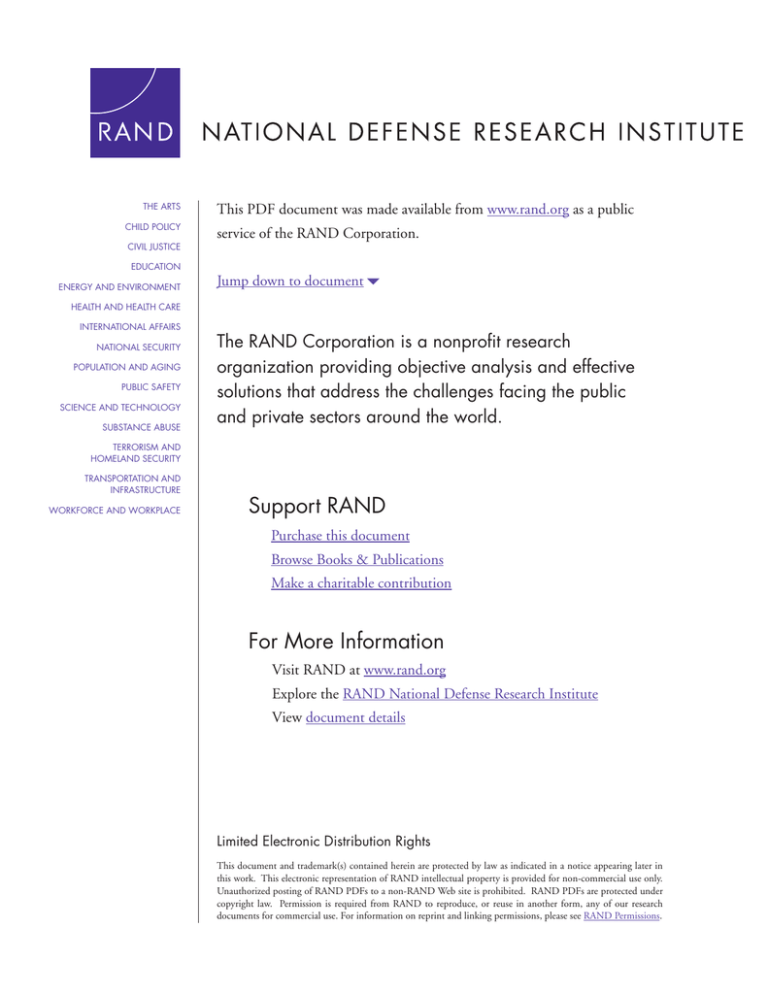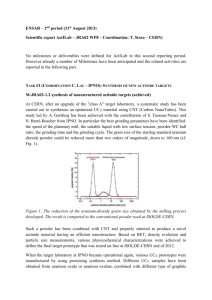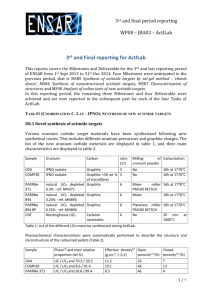
THE ARTS
CHILD POLICY
CIVIL JUSTICE
EDUCATION
ENERGY AND ENVIRONMENT
This PDF document was made available from www.rand.org as a public
service of the RAND Corporation.
Jump down to document6
HEALTH AND HEALTH CARE
INTERNATIONAL AFFAIRS
NATIONAL SECURITY
POPULATION AND AGING
PUBLIC SAFETY
SCIENCE AND TECHNOLOGY
SUBSTANCE ABUSE
The RAND Corporation is a nonprofit research
organization providing objective analysis and effective
solutions that address the challenges facing the public
and private sectors around the world.
TERRORISM AND
HOMELAND SECURITY
TRANSPORTATION AND
INFRASTRUCTURE
WORKFORCE AND WORKPLACE
Support RAND
Purchase this document
Browse Books & Publications
Make a charitable contribution
For More Information
Visit RAND at www.rand.org
Explore the RAND National Defense Research Institute
View document details
Limited Electronic Distribution Rights
This document and trademark(s) contained herein are protected by law as indicated in a notice appearing later in
this work. This electronic representation of RAND intellectual property is provided for non-commercial use only.
Unauthorized posting of RAND PDFs to a non-RAND Web site is prohibited. RAND PDFs are protected under
copyright law. Permission is required from RAND to reproduce, or reuse in another form, any of our research
documents for commercial use. For information on reprint and linking permissions, please see RAND Permissions.
This product is part of the RAND Corporation technical report series. Reports may
include research findings on a specific topic that is limited in scope; present discussions of the methodology employed in research; provide literature reviews, survey
instruments, modeling exercises, guidelines for practitioners and research professionals, and supporting documentation; or deliver preliminary findings. All RAND
reports undergo rigorous peer review to ensure that they meet high standards for research quality and objectivity.
Explaining the Increase
in Unemployment
Compensation for
Ex-Servicemembers During
the Global War on Terror
David S. Loughran, Jacob Alex Klerman
Prepared for the Office of the Secretary of Defense
Approved for public release; distribution unlimited
NATIONAL DEFENSE RESEARCH INSTITUTE
The research described in this report was prepared for the Office of the Secretary of
Defense-Reserve Affairs and conducted within the Forces and Resources Policy Center
of the RAND National Defense Research Institute (NDRI), a federally funded research
and development center sponsored by the Office of the Secretary of Defense, the Joint
Staff, the Unified Combatant Commands, the Department of the Navy, the Marine
Corps, the defense agencies, and the defense Intelligence Community under Contract
W74V8H-06-C-0002.
Library of Congress Cataloging-in-Publication Data is available for this publication.
ISBN 978-0-8330-4514-0
The RAND Corporation is a nonprofit research organization providing objective analysis
and effective solutions that address the challenges facing the public and private sectors
around the world. RAND’s publications do not necessarily reflect the opinions of its
research clients and sponsors.
R® is a registered trademark.
© Copyright 2008 RAND Corporation
All rights reserved. No part of this book may be reproduced in any form by any electronic or
mechanical means (including photocopying, recording, or information storage and retrieval)
without permission in writing from RAND.
Published 2008 by the RAND Corporation
1776 Main Street, P.O. Box 2138, Santa Monica, CA 90407-2138
1200 South Hayes Street, Arlington, VA 22202-5050
4570 Fifth Avenue, Suite 600, Pittsburgh, PA 15213-2665
RAND URL: http://www.rand.org
To order RAND documents or to obtain additional information, contact
Distribution Services: Telephone: (310) 451-7002;
Fax: (310) 451-6915; Email: order@rand.org
Summary
Between 2002 and 2004, the number of veterans receiving Unemployment Compensation for
Ex-Servicemembers and the cost of this program to the U.S. Department of Defense (DoD)
increased by about 75 percent (see Figure S.1). The UCX program is the military counterpart
to the civilian Unemployment Insurance (UI) program, which provides income assistance to
the unemployed as they search for work. Honorably discharged active-component personnel
and reserve-component personnel completing a period of active-duty service of 90 or more days
are eligible to receive UCX benefits provided that they meet other federal and state-specific
requirements of the UI system.
The sharp and sustained increase in the UCX caseload since 2002 has contributed to
concerns that veterans of the wars in Iraq and Afghanistan are having difficulty transition-
30
160
25
130
20
100
15
70
UCX claims
UCX payments
10
2000
40
2001
2002
2003
2004
2005
2006
Year-quarter
SOURCE: U.S. Department of Labor, Employment and Training Administration.
RAND TR588-S.1
xi
2007
UCX payments ($ millions)
UCX recipients (thousands)
Figure S.1
Average Weekly UCX Caseload, by Quarter
xii
Explaining the Increase in UCX During the Global War on Terror
ing to the civilian labor market. The research reported in this document examines the reasons
why the UCX caseload has risen and considers the implications of those findings for the UCX
program.
Data
To understand this increase in the UCX caseload, we drew on several data sources. We began by
analyzing aggregate data on the UCX program maintained by the U.S. Department of Labor
(DoL), Employment and Training Administration (ETA). We then created an individual-level
database of UCX recipients. That database began with a sample of UCX recipients obtained
from hard-copy reports maintained by the individual military services. Data limitations and
considerations of cost led us to select two quarters of these data to be key-punched into electronic form: the second quarter of 2005 for the Army, Air Force, Navy, and Marine Corps and
the second quarter of 2002 for the Army and Air Force alone (data on the Navy and Marine
Corps were not available for that quarter). The two quarters were selected so as to span the
observed increase in the UCX caseload.
We augmented these individual-level data on UCX claims by incorporating information
from service records on component, rank, dates of service and deployment, and self-reported
health from the Post-Deployment Health Assessment (PDHA). We also analyzed survey data
on post-activation employment of reservists from the Status of Forces Survey of Reserve Component Members (SOFS-R).
Rising UCX Eligibility and Claim Rates
We find that the increase in the UCX caseload is attributable both to large increases in the
number of veterans potentially eligible to receive UCX and to large increases in the fraction
of potentially eligible veterans who claim UCX (the claim rate). As can be seen in Figure S.2,
the number of reservists completing an activation of 90 or more days, and therefore potentially
eligible to receive UCX, increased sharply following September 11, 2001, as reservists were
deployed to assist with homeland security and to support operations in Afghanistan. With
the beginning of Operation Iraqi Freedom in early 2003, reserve deactivations increased to
unprecedented levels. By contrast, active-component separations have been relatively stable
since 2000.
These trends in the numbers of veterans eligible to receive UCX suggest that a significant
proportion of the overall increase in the UCX caseload is attributable to the intensive use of the
reserve components in the Global War on Terror. The individual-level data allow us to identify
the service and component of UCX claimants. Computations based on these individual UCX
claim data for the second quarter of 2002 and the second quarter of 2005 imply that approximately 58 percent of the increase in the UCX caseload between 2002 and 2005 is attributable
to the Army reserve components. We estimate that the Air Force, Navy, and Marine Corps
reserve components account for a very small fraction of the overall increase in the UCX caseload between those years, which leaves the balance of the increase (about 40 percent) to the
active components.
Summary
xiii
Figure S.2
Active- and Reserve-Component Demobilizations, by Quarter
100
Demobilizations (thousands)
80
60
40
20
Active component
Reserve component
0
2000
2001
2002
2003
2004
2005
2006
Year-quarter
SOURCES: Work Experience file, Active Duty Pay file, and Reserve Pay file.
NOTE: Counts exclude the Coast Guard.
RAND TR588-S.2
We also use these individual-level data to decompose the increase in the Army and Air
Force UCX caseload into two parts: (1) increases in eligibility and (2) increases in the fraction of eligible reservists who claim UCX (data limitations prevent us from performing this
decomposition for the Navy and Marine Corps). Specifically, from the individual-level data,
we compute the probability of claiming UCX in a quarter for each component. Then, we compute the effect of changes in eligibility by using observed eligibility in each period, but holding
the claim rates constant at their mean value. Similarly, we compute the effect of changes in
claiming by using observed claiming rates, but holding the number of eligible servicemembers
constant at their mean value.
Table S.1 tabulates the result of that analysis. Eligibility more than doubled in the Air
Force reserve components and nearly tripled in the Army components. Changes in eligibility explain more than half the increase in the UCX caseload in both the Army and Air Force
reserve components. Changes in active-component eligibility are much smaller (14 percent in
the Army and 12 percent in the Air Force). Nevertheless, changes in eligibility explain about
xiv
Explaining the Increase in UCX During the Global War on Terror
Table S.1
The Effect of Eligibility and Claiming on the Increase in the UCX Caseload Between
the Second Quarters of 2002 and 2005
Active Component
Reserve Component
Army
Air Force
Army
Air Force
14
12
175
106
0.6
2.5
4.9
0.9
Increase in eligibility
26
55
54
53
Increase in claim rates
74
45
46
47
Percentage increase in eligibility
Percentage-point increase in claim rate
Share of increase in UCX caseload
attributable to
SOURCE: RAND UCX database.
one-quarter of the increase in the UCX caseload in the Army active component and more than
half of the increase in the Air Force active component.
Deployment Duration, Post-Deployment Health, and UCX Claim Rates
While increases in the number of veterans eligible to receive UCX have been important, rising
claim rates have also played an important role. Nearly half of the increase in the Air Force
active- and reserve-component caseload, three-quarters of the Army active-component caseload, and half of the Army reserve-component caseload are accounted for by rising claim
rates.
It seems unlikely that the increase in claim rates is due to a deterioration in the civilian
labor market. Between 2002 and 2005, the overall civilian labor market generally improved;
for example, civilian UI claims decreased markedly between these two years.1 Instead, it seems
likely that the increase in claim rates is due to changes in the nature of military service. We
show that long deployments have become much more common and that longer deployments
are associated with much higher claim rates. Our decomposition analysis suggests that these
longer deployments explain more than a third of the overall increase in the Army active and
reserve UCX caseload between 2002 and 2005 (similar analyses could not be conducted for
other services).
We also explored the relationship between post-deployment health status (as measured
in the PDHA) and UCX utilization among Army active- and reserve-component members.
We show that self-reported health worsens with length of deployment and that poor reported
health is associated with higher UCX claim rates. However, while these correlations are statis-
1
The official Current Population Survey (CPS-based unemployment rate of younger veterans (ages 20–24) increased
between 2003 and 2005 (while the unemployment rate of nonveteran youth declined). However, the official unemployment
rate returned to 2003 levels in 2006. The decline in the unemployment rate of younger veterans in 2006 and a more formal
analysis in earlier research (Savych, Klerman, and Loughran, 2008) suggest that the observed increase in veteran youth
unemployment between 2003 and 2005 most likely reflects sampling variation rather than the influence of real economic
factors. Thus, there is no clear evidence of either an improvement or worsening of the employment prospects of young
veterans.
Summary
xv
tically significant, our analysis suggests that they are not large enough to explain much of the
overall increase in the Army UCX caseload.
The Employment Experiences of Army Reserve-Component UCX Recipients
In 2005, more than 19 percent of eligible Army active-component and 15 percent of eligible
Army reserve-component members claimed UCX benefits following demobilization. The high
claim rates of Army active-component members are perhaps more easily understood than the
high claim rates of Army reserve-component members. Most active-component veterans have
no recent civilian labor market experience. It is, therefore, plausible that many will require
some time to find civilian employment that takes advantage of the skills they developed in the
military.
The situation with reservists is quite different. The Uniformed Services Employment and
Reemployment Rights Act (USERRA) of 1994 (P. L. 103-353) guarantees reservists employed
at the time of activation the right to return to that job following activation. Since, as with
UI, UCX generally requires that recipients accept suitable employment, the availability of a
USERRA-protected job should make it less likely that a reservist would be eligible to receive
UCX.2
However, our tabulations from the SOFS-R indicate that 59 percent of reservists who
received UCX in the three months following deactivation were employed in the month prior
to being activated. The SOFS-R asked these reservists why they had not returned to their preactivation job. We classified those reasons as either involuntary (e.g., employer went out of
business, change in employer circumstances, failure to offer prompt employment) or voluntary
(e.g., disliked previous job, decided to attend school, “needed a break”) in nature. Overall,
among Army reservists who did not return to their pre-activation employer and instead collected UCX, 40 percent listed only voluntary reasons, 34 percent listed both voluntary and
involuntary reasons, and 26 percent listed only involuntary reasons.
Implications
Our analyses suggest that the sharp rise in the UCX caseload is not evidence of a substantial
weakening of the civilian labor market for recent veterans. Instead, our analyses suggest that
the increase in the UCX caseload is due to changes in the population of veterans eligible for
UCX. This includes a sharp increase in the number of veterans who qualify on the basis of
their reserve service and a sharp increase in the length of reserve deployments.
Nevertheless, the sharp increase in the UCX caseload might suggest a rethinking of the
UCX program. It appears that many reservists collecting UCX have a USERRA-protected job
to which they have a statutory right to return. Policymakers might consider administrative
steps to ensure that reservists claiming UCX understand that a USERRA-protected job will
usually make them ineligible for UCX and to ensure that state UI program employees deter2
The availability of a USERRA-protected job does not automatically disqualify reservists from receiving UCX. State
workforce agencies make eligibility determinations based on a variety of other considerations, some of which vary from state
to state. However, availability of suitable employment is a major consideration.
xvi
Explaining the Increase in UCX During the Global War on Terror
mine whether claimants have access to a USERRA-protected job before granting UCX benefits.3 Discussions with DoL ETA staff suggest that official guidance on this issue was ambiguous through mid-2007 and that additional guidance to reservists and to state UI offices and
employees might be useful.4
Alternatively, policymakers might decide that UCX is an appropriate vehicle for delivering income support to reservists who are recuperating from a stressful deployment and possibly
considering alternative civilian employment.5 It should be noted that any such UCX-funded
leave would be in addition to paid leave accumulated while serving on active duty and that
USERRA already allows reservists up to three months to return to their pre-activation job
(though USERRA itself does not provide any income during that period).
3 We use “policymakers” generically here to refer to federal and state agencies with authority to enforce and interpret UCX
and USERRA statutes and regulations.
4
The ambiguity arises from a disparity between the language contained in the UCX Handbook (DoL ETA, 1994, Chapter IV, 7.a) and that in the Unemployment Insurance Program Letter (UIPL) No. 27-06 (DoL ETA, 2006b). The guidance
contained in UIPL No. 27-06, issued in August 2006, is correct. DoL is revising the UCX Handbook to conform to the
guidance contained in UIPL 27-06.
5
Such a change would require a legislative change to the UCX statute, which, as written (20 U.S.C.F.R., Part 614),
requires individuals to be able and available to work. Most states also require that individuals be actively seeking work.






